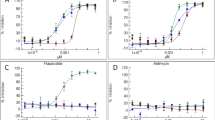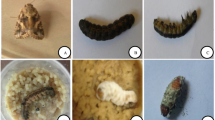Abstract
Pathogenicity of Rhabditis blumi Sudhaus against major cruciferous insect pests was evaluated in the lab and greenhouse. In Petri-dish tests against the insects, including Artogeia rapae L., Mamestra brassicae L., and Plutella xylostella L., insect mortality by R. blumi and its associated bacteria was dose and time dependent, which increased with dose (0–80 dauer juveniles/larva) and time increments. Pathogenicity against fourth-instar larvae was higher than the rate of corresponding third-instar larvae. The highest insect mortality rate was observed in fourth-instar larvae of P. xylostella, followed by A. rapae, and M. brassicae, with mortality rates of 93.5, 88.2, and 77.8 %, respectively. Lethal dose values at 50 % (LD50) of R. blumi were 25.7 dauer juveniles/larva on P. xylostella; 28.0 dauer juveniles/larva on A. rapae; and 40.6 dauer juveniles/larva on M. brassicae, respectively. In greenhouse tests, P. xylostella larvae were most susceptible to nematodes, with insect reduction rate of 88.0 %. The rate varied with vegetable species and persistence time of live nematodes on vegetable leaves after spraying. Nematodes established in cadavers showed positive correlation with nematode dose, whereas nematode persistence on the leaf was inversely related to hours after treatment.





Similar content being viewed by others
References
Baur ME, Kaya HK, Thurston GS (1995) Factors affecting entomopathogenic nematode infection of Plutella xylostella on a leaf surface. Entomol Exp Appl 77:239–250. doi:10.1111/j.1570-7458.1995.tb02321.x
Baur ME, Kaya HK, Tabashnik BE, Chilcutt CF (1998) Suppression of diamondback moth (Lepidoptera: Plutellidae) with an entomopathogenic nematode (Rhabditida: Steinematidae) and Bacillus thuringiensis Berliner. J Econ Entomol 91:1089–1095 (PMID: 9805498)
Bélair G, Fournier Y, Dauphinais N (2003) Efficacy of steinernematid nematodes against three insect pests of crucifers in Quebec. J Nematol 35:259–265 PMCID: PMC2620653
Bilgrami AL, Gaugler R, Shapiro-Ilan DI, Adams BJ (2006) Source of trait deterioration in entomopathogenic nematodes Heterorhabditis bacteriophora and Steinernema carpocapsae during in vivo culture. Nematology 8:397–409. doi:10.1163/156854106778493394
Brewer MJ, Trumble JT (1989) Field monitoring for insecticide resistance in beet armyworm (Lepidoptera: Noctuidae). J Econ Entomol 82:1520–1526
Cabanillas HE (2003) Susceptibility of the boll weevil to Steinernema riobrave and other entomopathogenic nematodes. J Invertebr Pathol 82:188–197. doi:10.1016/S0022-2011(03)00016-8
Carta LK, Osbrink W (2005) Rhabditis rainai n. sp. (Nematoda: Rhabditida) associated with the Formosan subterranean termite, Coptotermes formosanus (Isoptera: Rhinotermitidae). Nematology 7:863–879. doi:10.1163/156854105776186299
Gaugler R (1988) Ecological considerations in the biological control of soil-inhabiting insects with entomopathogenic nematodes. Agric Ecosyst Environ 24:351–360. doi:10.1016/0167-8809(88)90078-3
Grewal P, Georgis R (1999) Entomopathogenic nematodes. In: Hall FR, Menn JJ (eds) Biopesticides: use and delivery (Methods in biotechnology vol. 5). Humana Press, Totowa, pp 271–299
Kaya HK, Gaugler R (1993) Entomopathogenic nematodes. Annu Rev Entomol 38:181–206. doi:10.1146/annurev.en.38.010193.001145
Kaya HK, Stock SP (1997) Techniques in insect nematology. In: Lacey LA (ed) Manual of techniques in insect pathology. Academic Press, San Diego, pp 281–324
Kim GH, Seo YS, Lee JH, Cho KY (1990) Development of fenvalerate resistance in the diamondback moth, Plutella xylostella Linne (Lepidoptera: Yponomeutidae) and its cross resistance. Korean J Appl Entomol 29:194–200 (in Korean with English summary)
Kim HH, Jeon HY, Yang CY, Jang HI, Kang SH, Yiem MS, Choo HY (2005) Biological control of major moths using entomopathogenic nematode, Steinernema carpocapsae in the spring Chinese cabbage. Korean J Hortic Sci 23(S1):85 (in Korean)
Kim HH, Cho SR, Lee DW, Jeon HY, Park CG, Choo HY (2006) Biological control of diamondback moth, Plutella xylostella with Korean isolates of entomopathogenic nematodes (steinernematid and heterorhabditid) in greenhouse. Korean J Appl Entomol 45:201–209 (in Korean with English summary)
Kiontke K, Sudhaus W (2006) Ecology of Caenorhabditis species (January 09, 2006). In: WormBook (ed) The C. elegans Research Community. WormBook. doi:10.1895/wormbook.1.37.1, http://www.wormbook.org
Mahmoud MF, Osman MAM (2007) Use of the nematode Steinernema feltiae Cross N 33 as a biological control agent against the peach fruit fly Bactrocera zonata. Tunis J Plant Prot 2:109–115. http://www.iresa.agrinet.tn/tjpp/tjpp4/Farag2ImpF.pdf
Msolla P, Falmer-Hansen J, Musemakweli J, Monrad J (1985) Treatment of bovine parasitic otitis using ivermectin. Trop Anim Health Prod 17:166–168. doi:10.1007/BF02355877
Msolla P, Semuguruka WD, Kassuku AA, Shoo MK (1993) Clinical observations of bovine parasitic otitis in Tanzania. Trop Anim Health Prod 25:15–18. doi:10.1007/BF02236880
Ooi PAC (1980) Laboratory studies of Diadegma cerophagous (Hym.: Ichneumonidae), a parasite introduced to control Plutella xylostella (Lep.: Hyponomeutidae) in Malaysia. Entomophaga 25:249–259. doi:10.1007/BF02371924
Padmakumari AP, Prasad JS, Katti G, Sankar M (2007) Rhabditis sp (Oscheius sp), a biocontrol agent against rice yellow stem borer, Scirpophaga incertulas. Indian J Plant Prot 35:255–258
Park HW, Kim YO, Ha J-S, Youn SH, Kim HH, Bilgrami AL, Shin CS (2011) Effects of associated bacteria on the pathogenicity and reproduction of the insect-parasitic nematode Rhabditis blumi (Nematoda: Rhabditida). Can J Microbiol 57:750–758. doi:10.1139/W11-067
Saleh MME, Draz KAA, Mansour MA, Hussein MA, Zawarah MFM (2009) Controlling the sugar beet beetle Cassida vittata with entomopathogenic nematodes. J Pest Sci 82:289–294. doi:10.1007/s10340-009-0253-1
Salem SA, Abdel-Rahman HA, Zebitz CPW, Saleh MME, Ali FI, El-Kholy MY (2007) Evaluation of entomopathogenic nematodes in controlling some cabbage pests. J Appl Sci Res 3:323–328. http://www.aensionline.com/jasr/jasr/2007/323-328.pdf
Schulte F (1989) The association between Rhabditis nectomena Sudhaus & Schulte, 1989 (Nematoda: Rhabditidae) and native and introduced millipedes in South Australia. Nematologica 35:82–89. doi:10.1163/002825989X00089
Sereda B, Basson NCJ, Marais P (1997) Bioassay of insecticide resistance in Plutella xylostella (L.) in South Africa. Afr Plant Prot 3:67–72
Shinde S, Singh NP (2000) Susceptibility of diamond back moth, Plutella xylostella (L) to entomopathogenic nematodes. Indian J Exp Biol 38:956–959 PMID: 12561960
Sudhaus W, Schulte F (1989) Rhabditis (Rhabditis) necromena sp. n. (Nematoda: Rhabditidae) from South Australian diplopoda with notes on its siblings R. myriophila Poinar, 1986 and R. caulleryi Maupas, 1919. Nematologica 35:15–24. doi:10.1163/002825989X00025
Tabashnik BE (1994) Evolution of resistance to Bacillus thuringiensis. Annu Rev Entomol 39:47–79. doi:10.1146/annurev.en.39.010194.000403
Talekar NS, Shelton AM (1993) Biology, ecology, and management of the diamondback moth. Annu Rev Entomol 38:275–301. doi:10.1146/annurev.en.38.010193.001423
Wilson MJ, Glen DM, George SK, Butler RC (1993) Mass cultivation and storage of the rhabditid nematode Phasmarhabditis hermaphrodita, a biocontrol agent for slugs. Biocontrol Sci Technol 3:513–521. doi:10.1080/09583159309355307
Wilson MJ, Glen DM, George SK, Pearce JD (1995) Selection of a bacterium for the mass production of Phasmarhabditis hermaphrodita (Nematoda: Rhabditidae) as a biocontrol agent for slugs. Fundam Appl Nematol 18:419–425. http://horizon.documentation.ird.fr/exl-doc/pleins_textes/fan/010004272.pdf
Yun JS, Kim HH, Kim DW, Lee SM, Kim DS, Lee DW (2004) Pathogenicities of entomopathogenic fungi, Beauveria bassiana and Metarhizium anisopliae against lepidopterous insect pests, Agrotis segetum, Artogeia rapae, Mamestra brassicae, Plutella xylostella, Spodoptera exigua and Spodoptera litura. Korean J Turfgrass Sci 18:221–229
Acknowledgments
The authors are grateful to Dr. Dong-Ro Choi (Director general, National Institute of Horticultural and Herbal Science, South Korea) for his great assistance, and Dr. John Chitambar (Senior plant nematologist, California Department of Food and Agriculture, USA) for his help in identifying nematode species. This work was partly supported by the Korea Student Aid Foundation (KOSAF) Grant funded by the Korea government (MEST) (No. S2-2007-000-00908-1).
Author information
Authors and Affiliations
Corresponding author
Rights and permissions
About this article
Cite this article
Park, H.W., Kim, H.H., Youn, S.H. et al. Biological control potentials of insect-parasitic nematode Rhabditis blumi (Nematoda: Rhabditida) for major cruciferous vegetable insect pests. Appl Entomol Zool 47, 389–397 (2012). https://doi.org/10.1007/s13355-012-0131-9
Received:
Accepted:
Published:
Issue Date:
DOI: https://doi.org/10.1007/s13355-012-0131-9




